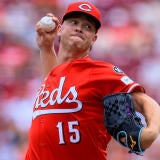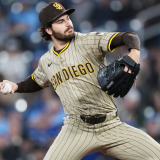Fantasy Baseball: Early first base rankings for 2017
Hanley Ramirez has made a huge leap with his performance the last few weeks, but Scott White isn't ready to call him top-10 at what's shaping up to be a deep position again.

Early 2017 rankings: 1B | 2B | 3B | SS | C | OF | SP | RP
For all the worry coming into 2016 about getting left out of the first base run, it ended up being a pretty easy position to fill.
Which is something to remember going into 2017. If you don’t like what you see here, well, it’s only a starting point.
As essential as versatility is in today’s game and as transferable as other skills are to the position, first base ends up being the go-to secondary spot for any player whose bat needs to stay in the lineup.
Just look at this list of players losing first base eligibility next year: Kris Bryant, Buster Posey, Jonathan Lucroy, Mark Trumbo, Victor Martinez, Adam Duvall, Logan Forsythe, Yangervis Solarte, Matt Holliday and Brandon Moss.
Why are they losing it? Well, they didn’t get the 20 games necessary to retain eligibility from one year to the next. But it only takes five games to gain eligibility in-season, and seeing as first base is a fallback position for so many, the number of usable options there should increase faster than at most positions.
Not that it really needs them.
Top 10 first basemen for 2017:
1. Paul Goldschmidt, 1B, Diamondbacks
2. Anthony Rizzo, 1B, Cubs
3. Miguel Cabrera, 1B, Tigers
4. Joey Votto, 1B, Reds
5. Edwin Encarnacion, 1B, Blue Jays
6. Daniel Murphy, 1B/2B, Nationals
7. Matt Carpenter, 1B/2B/3B, Cardinals
8. Freddie Freeman, 1B, Braves
9. Wil Myers, 1B, Padres
10. Jose Abreu, 1B, White Sox
In a year when home runs have spiked across the league, Paul Goldschmidt has hit only two-thirds as many as we expected from him, and yet here he is at the top of the heap still. That’s because he validated another aspect of his game that nobody was willing to presume coming into the season: stolen bases.
Aside from Mike Trout, Mookie Betts and Jose Altuve, who figure to go one, two and three in some order, he’s now the preeminent source of steals among first-round hitters, which is a big deal in Rotisserie leagues. And in standard Head-to-Head leagues that award two points per stolen base, it has kept him in the same class as superior home run sources Anthony Rizzo and Edwin Encarnacion all year.
Of course, they’ve only been superior home run sources this year. Goldschmidt is 29, so the chances of him bouncing back with another 30-homer season are high. Provided he’s still stealing bases, he’d pull away from the pack in that scenario.
Exactly where the top tier ends and the second begins is kind of murky. Only Goldschmidt and Rizzo are projected first-rounders for me, but the next five could all be off the board by the end of Round 2. The ones I think have a legitimate chance of hanging with Goldschmidt are the top six, ending with Murphy.
That doesn’t mean they’re equally safe. Cabrera, Votto, Encarnacion and Murphy are all on the wrong side of 30, which brings with it increased health risks. Encarnacion, an impending free agent, will almost certainly wind up in a less favorable environment, given the one he’s already in. Murphy doesn’t have the track record of the other three, but because his contact skills are readily evident and power gains traceable to last year, it’s almost a non-issue to me.
The bigger question for Murphy is if he’ll actually be drafted to play first base. Second base now rivals it in depth, but that won’t stop an owner from beginning his draft with Goldschmidt in Round 1 and Murphy in Round 2, which would change the first base landscape slightly by forcing the rest of the league to go one spot deeper.
That’s almost certain to happen with Carpenter since he’s also eligible at third base, which might be the weakest infield position to begin 2017. It’s why he sneaks into my second round even after an uneven season that keeps him out of the top tier here.
And that’s where things start to get a little worrisome at first base. It’s a glass-half-empty way of looking at things, I guess, given that Freeman has been the top first baseman from June 13 on, blowing away his previous career high in home runs at an age (26 most of the year) when a power boost is halfway expected, but he has sacrificed some contact along the way, which would suggest maybe the complete package is a little too good to be true.
Then again, he has always been a high-BABIP guy, hitting the ball to all fields with an exceptional line-drive rate. Maybe he really is this good, which would add to the elite tier at the position. If nothing else, his power gains should give him a high floor.
Of course, we were saying the same thing at the All-Star break about Wil Myers, and look what has become of him. He doesn’t even strike out as often as Freeman does, and yet his BABIP suggests his substandard batting average is right where it belongs. His biggest problem, as far as I can tell, is that he stopped homering so much, which I’d be willing to dismiss as a fluke if he had the track record to back it up. But of course, he offered nothing but disappointment before this year.
I might rank him behind Abreu, who has completely redeemed himself in the second half after his own power drought in the first, if not for the fact he’s the only first baseman other than Goldschmidt who runs. If he’s good for a 25-25 season, you can live with a .250 batting average from Myers.
Next 10 first basemen for 2017:
11. Chris Davis, 1B, Orioles
12. Hanley Ramirez, 1B, Red Sox
13. Albert Pujols, 1B, Angels
14. Carlos Santana, 1B, Indians
15. Eric Hosmer, 1B, Royals
16. Mike Napoli, 1B, Indians
17. C.J. Cron, 1B, Angels
18. Brandon Belt, 1B, Giants
19. Adrian Gonzalez, 1B, Dodgers
20. Brad Miller, 1B/SS, Mariners
Chances are if you’ve started any of Nos. 1-16 at first base this year, you’re satisfied with the production you’ve received, which means the position has offered more than enough to go around in a 12-team league. That’s all you can really ask from any position.
Some in this second group suffer from a limited ceiling. Others have potentially debilitating flaws that just haven’t manifested this year. Ramirez’s three-week power binge pushes him into the top 12 almost by default. He doesn’t have the most even track record, of course, but his supporting cast should help make up for any regression in home runs next year.
For years, we’ve been anticipating such a regression for Albert Pujols, the now 36-year-old with the chronic foot issue and the extreme pull tendencies, but he keeps slugging his way into the elite. Or at least just outside of it. His low strikeout rate gives him an extra little boost in points leagues.
He’s not the most format-dependent player here, though -- not by a long shot. That honor goes to Mr. Santana, who’s consistently in the running for most format-dependent player overall as a low-batting average, high-on base guy. Walks don’t count for anything in standard Rotisserie leagues, but they’re worth a point apiece in standard Head-to-Head, where -- what do you know? -- rate stats like batting average don’t matter. You see the conflict there.
Santana has had a career season in terms of home runs, which has helped close the gap a little between the two formats, but with his 19-homer 2015 still fresh on everyone’s minds, I could see why a Rotisserie owner might look elsewhere.
Problem is the players who follow have their own shortcomings. Hosmer’s middling power is even harder to overlook with home runs back on the rise in baseball, and it’s not like he stands out in any other area. For Napoli, himself enjoying a power surge this year, the issue is less about upside than downside. The former catcher looked like he might not find an everyday job after a disastrous stay in Boston last year, and as a low-contact 35-year-old looking at another change of scenery this offseason, he could certainly backslide.
Belt and Gonzalez are in the same boat as Hosmer: In a homer-laden sport (not to mention a homer-heavy position), they’re too boring to justify a hefty investment. The upside play at that stage of the draft would be Cron, who has a surprisingly good contact rate for a player with 30-homer potential. He has yet to prove it over a full season, of course, but in 44 games dating back to mid-June, he’s batting .315 with a .939 OPS. His BABIP during that time is a perfectly sustainable .326.
You’ll find additional upside picks outside of the top 20. Greg Bird homered 11 times in 157 at-bats for the Yankees last year, remember, and should be poised to take over for the retiring Mark Teixeira after taking a year to recover from shoulder surgery. Josh Bell could develop into an OPS monster for the Pirates if he’s not too much of a defensive liability to play every day. And A.J. Reed shouldn’t be automatically dismissed because of a poor rookie showing.
They’re basically lottery tickets, though. By that point in the draft, nobody should have an opening at first base or corner infield still, so nobody’s fate is tied to an unknown -- a comforting reminder at a position that made so many uncomfortable back in March.
























